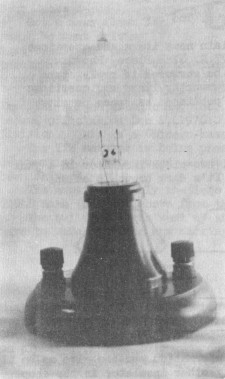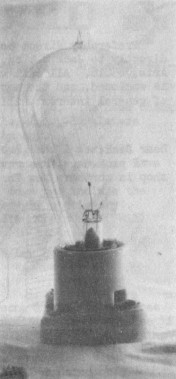"Wire In A Bottle"
by Alan Rodgers
Reprinted from "INSULATORS - Crown Jewels of the Wire", January 1978, page 20
"Edison's first simple 'wire in a bottle' was one of the first
electrical devices."
As a collector of insulators and related electrical
items, I became fascinated with old glass light bulbs.
"Fundamentally, an
incandescent lamp is a simple thing -- just a wire sealed in a glass bulb with a
few supplementary parts, but it is very precisely made. Electric current passing through the filament wire heats it to incandescence, and light is produced.
It is necessary to heat the filament to temperatures in the neighborhood of 5000
(degrees) F., yet the filament does not burn up because it is either in a vacuum or
is surrounded by inert gases that do not combine chemically with the tungsten
metal. A tungsten filament operates at a temperature higher than that of any
heat source ordinarily encountered by man - a temperature at which asbestos or
fire brick would melt like wax in a furnace -- and twice the temperature of
molten steel.
"The filament of a 6-watt 120-volt lamp is less than half a
thousandth of an inch in diameter, visible only to the best of eyes. Side by
side more than 2,000 fit in a one-inch space. Yet this wire is remarkably strong
- in a 'cold' state, it is four times as strong as steel wire of the same
diameter.
"A filament which, in a single spot, is only one per cent smaller
in diameter than specifications may reduce lamp life by 25 per cent. (In a
6-watt lamp, this would mean a difference in diameter of about five-millionths
of an inch.) The reduction in life would be due to the more rapid evaporation of
tungsten at the 'thin' spot. Some filaments are made by coiling tungsten wire
around a mandrel which must be accurate to one ten-thousandth of an inch, or
life may be affected as much as 20 per cent. Spacing between coils must be
rigidly accurate, not only to avoid short-circuiting but also to avoid
concentration of heat at one point. Inaccurate spacing may affect life by 10 per
cent. Furthermore, a single drop of moisture distributed among 500,000 lamps
will cause early blackening in all of them.
"A 100-watt coiled-coil
filament starts as a tungsten wire 0.00249 inches in diameter and 23 inches
long. After the first coiling, the length is reduced to 3 7/8 inches. The coil,
now consisting of 850 turns, is again coiled, leaving the finished filament only
11/16 inches in length. Because of the high concentration of heat with this
coiled-coil filament, efficiency over the single-coiled filament of the same
length is increased by 10 per cent...."
There you have it, "everything
you always wanted to know about a light bulb..." as told by the General
Electric Company lamp division.

Replica of Edison's first
operational lamp - 1880's |

1903 cargon filament
light build |
The very old carbon filament lamps are collectible and will make an addition
to a collection.
Several of even the oldest bulbs in my collection are still
operational. They include a heavy glass bulb filled with bubbles and flaws,
pointed top and various patent dates. The dates refer to a time period around
the turn of the century. My insulator room is illuminated by an old porcelain
street light complete with insulator and carbon filament lamp. The rest are
supported by porcelain old sockets.
To find them, look around junk shops, barns,
old houses, etc. It is also amazing that such a fragile object such as a light
bulb could have survived nearly 3/4 of a century and still be in working
condition! It has been reported that a fire station in a central California town
still has an antique carbon filament light bulb "burning", nearly 3/4
of a century! (Don't make them like they used to.)
I must stop and ask myself -
another "bright idea", collecting antique light bulbs?
| 